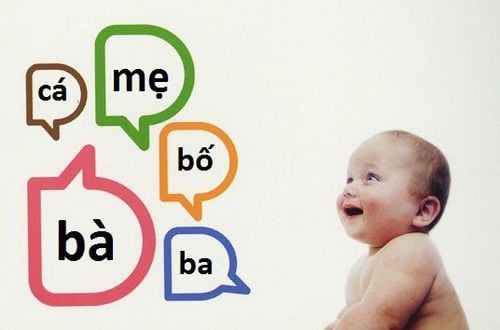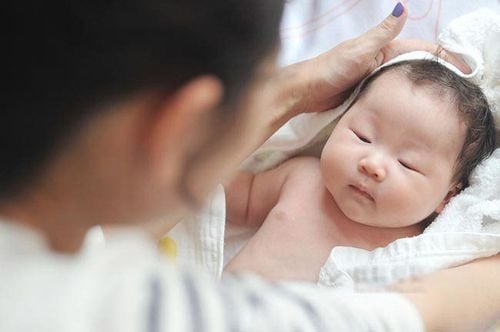This is an automatically translated article.
According to a recent new study, caregivers who regularly interact with children by eye and voice at one year of age are more likely to develop language skills by age two. So specifically, how does eye contact help babies develop language skills?
1. Research on children's eye contact and skill development
Before children learn to speak, they learn about nonverbal communication. Newborns pay attention to how their bodies communicate through everything from being held to being comforted. A recent study found that infants who used eye contact to communicate with caregivers showed increased language development in these infants. 1-year-olds who used voice while looking at their caregiver's face showed greater vocabulary growth by age 2 than children who didn't make regular eye contact.
Scientists say the findings should encourage parents to pay attention to babies' communication efforts before babies can use words and respond to others. For the study, researchers looked at the voices, gestures and eye contact of 11- and 12-month-old infants, as well as how caregivers responded to the babies. "Previous studies have never looked at these factors at the same time," said Dr Ed Donnellan from the University of Sheffield, lead author of the study.
To measure interactions, researchers videotaped infants and caregivers at home, and asked caregivers to play as usual. The researchers had to bring those videos back to the university and very meticulously encode what was happening between the child and the caregiver. Professor Michelle McGillion of the University of Warwick, co-author of the work published in the journal Developmental Science, said the team had to pay close attention every time infants spoke or acted. gesture and encode all caregiver responses.

Trẻ sơ sinh sẽ giao tiếp bằng ngôn ngữ ký hiệu trước khi học nói
The caregivers then filled out a questionnaire about whether their child could say certain words referring to animals, daily routines, and food.
The scientists then used statistical models to find that the best predictor of vocabulary at 24 months of age was when infants began to learn to speak while looking at faces caregiver when the child is about one year old. This benefit is even greater when these interactions are fed back to the child by caregivers.
Statistics show that by the age of 19 months, babies have an average of about 100 words. This tells us that babies are trying to communicate before they can say their first words. When children do this, they are giving caregivers an opportunity to communicate with them, and when caregivers interact with children, children are learning more vocabulary and developing language skills.
The team concludes that to help children develop language skills requires effort on the part of both the child and the caregiver. Caregivers need to keep an eye on what the child is learning and talk to the child about what is of interest to support the child's language development. In addition, caregivers can interact with children in any context at any time of the day. Talking and making eye contact with a child is not something that requires special equipment or even a lot of time. For example, caregivers can do it while doing housework, in the park, in the car, at mealtimes, in the shower.
McGillion hopes this work can lead to further studies at a wider range of ages. This is an overall picture of a child's development during the first year of life, but children are constantly developing and changing and their behavior changes year by year.

Cha mẹ có vai trò quan trọng trong việc giúp trẻ phát triển kỹ năng ngôn ngữ
2. How to make eye contact with children?
As a parent, you can use these findings to pay more attention to how you communicate with your child. You may be used to talking to your child, but take a moment and observe all the ways in which he communicates with you. When your baby cries, turns away, looks at you, or doesn't respond to sounds, these are all ways he's trying to tell you something. Respond to these signals the same way you would to someone who is talking to you. You should talk to your child about what he or she is trying to convey to you using statements such as, "Does that noise scare you?"
First, babies develop the ability to focus their eyes on the other person's face. As early as four days old, babies recognize their mother's face. The best way to support your baby's eye contact development is to look at your baby when you feed him, as babies can only see about 8 to 15 inches away, about the same distance as your face when holding your baby. .
Whether breastfed or bottle-fed, infants develop basic social skills by looking at their caregiver's face while feeding. When your baby stares into your eyes and shifts his gaze to something you're also looking at, it shows a mutual interest between him and you.
Children's ability to pay attention at the same time as adults develops between the ages of eight and 15 months. Your child has the ability to direct your attention, by looking at an object or toy he wants to have, and then back to your face for a continuous indication of the object or toy he wants you to get. for children. Guiding you with nonverbal gestures is also known as holographic gaze because the child connects three things by eye contact, including himself, something, and you. When your baby looks at you, then at the object he wants, then back at you, it shows he understands he can influence your actions. As children begin to use their eyes to show you what they want, they move from being a passive participant to an active one in the parent-child relationship.

Trẻ nhỏ từ tám đến 15 tháng tuổi bắt đầu có khả năng chú ý cùng lúc với người lớn
Face-to-face interactions between you and your child are more effective than interactions through video or audio recording, as face-to-face interactions give young children the opportunity to learn to use their eyes for nonverbal communication. Newborns rely on responses and interactions from their caregivers to shape their behaviour. When your baby makes sounds, you reward him with a big smile, physical touch, and talking to him. Before long, your baby will be making happy noises to get your attention and thus, begin to form a bond between you and your baby. Your responses to your baby's movements and sounds will encourage much of the same. Spending time with your baby is one of the best ways to help your baby learn. When a child has abnormal signs of health, parents can take the child to Vinmec Health system for timely examination and treatment.
As a key area of Vinmec Health System, Pediatrics Department - Vinmec International General Hospital always brings satisfaction to customers and is highly appreciated by industry experts thanks to the following advantages:
gathers a team of leading doctors and doctors in Pediatrics: including leading experts, with high professional qualifications (professors, associate professors, doctorates, masters), experienced, having worked in different hospitals. big hospitals like Bach Mai, 108.. The doctors are all well-trained, professional, have a heart - reach, understand young psychology. In addition to domestic pediatric specialists, the Department of Pediatrics also has the participation of foreign experts (Japan, Singapore, Australia, USA) who are always pioneers in applying the latest and most effective treatment regimens. . Comprehensive services: In the field of Pediatrics, Vinmec provides a series of continuous medical examination and treatment services from Newborn to Pediatric and Vaccine,... according to international standards to help parents take care of their baby's health from birth to childhood. from birth to adulthood Specialized techniques: Vinmec has successfully deployed many specialized techniques to make the treatment of difficult diseases in Pediatrics more effective: neurosurgery - skull surgery, stem cell transplantation. blood in cancer treatment. Professional care: In addition to understanding children's psychology, Vinmec also pays special attention to the children's play space, helping them to have fun and get used to the hospital's environment, cooperate in treatment, improve the efficiency of medical treatment.
Please dial HOTLINE for more information or register for an appointment HERE. Download MyVinmec app to make appointments faster and to manage your bookings easily.
Reference source: babycenter.com; theguardian.com; allinahealth.org












